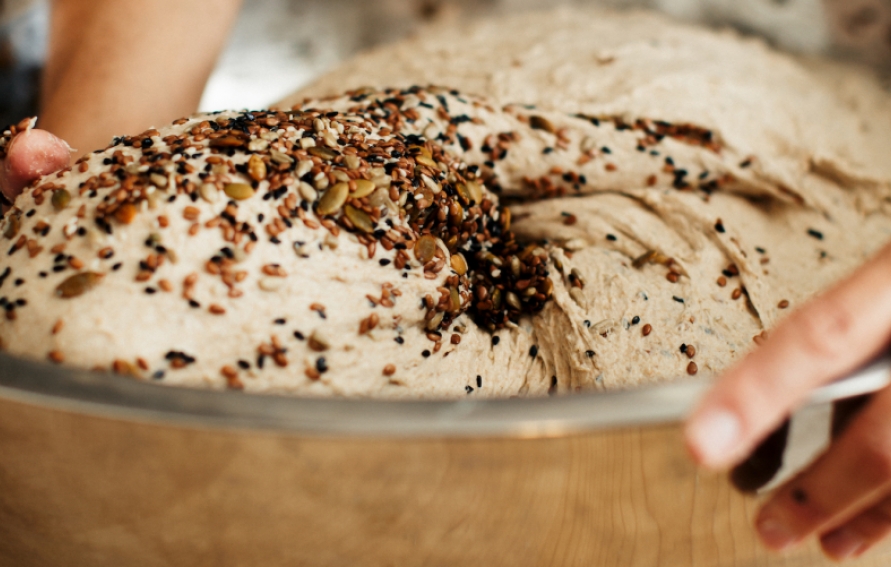Ingredients
- 25 grams sourdough starter, refreshed (fed)
- 45 grams water, tepid
- 45 grams whole rye flour
- 25 grams whole flax seeds
- 20 grams black sesame seeds
- 60 grams water
- 40 grams toasted pepitas or sunflower seeds
- 115 grams leaven
- 650 grams water
- 460 grams bread flour
- 300 grams whole-wheat flour
- 85 grams whole-rye flour
- 17 grams fine salt
Instructions
Prepare the leaven:
About 8 hours before you are to mix your dough, prepare the leaven. Place the starter and water in a large bowl and stir to a slurry. Add the flour and mix with a spoon until no dry lumps remain. Cover with plastic and allow to ferment at room temperature until you are ready to mix your dough.
Mix the dough:
When the leaven shows bubbles breaking the surface and has swelled considerably in size, add the water and stir to combine. Measure the flours into the bowl and, using your hands, mix and squeeze the dough in a circular motion until no dry lumps remain. Cover with plastic and autolyse (rest) the dough for about 20 minutes, allowing the flour to fully hydrate before adding the salt. Once the dough has rested, sprinkle the salt evenly over the surface of the dough and mix well to combine.
Bulk fermentation:
Set the bowl aside in a warm location (ideally 75°F) to bulk ferment for about 3½–4 hours. During this time, stretch and fold the dough in the bowl every 30–45 minutes to help develop the gluten network essential for trapping fermentation gases while at the same time incorporating the seeds. To do this, stir the toasted seeds into the soaked seeds and then evenly spread ⅓ of the mixture over the surface of the dough. Wet your hands first to prevent the dough from sticking and gently slide your fingers under the dough mass. Release the dough from the sides of the bowl and gently fold it to the center. Rotate the bowl and repeat 3–4 more times, until you have worked your way around the dough. Repeat this process every 30–45 minutes, incorporating more seeds and being especially careful toward the end of bulk fermentation not to over aggressively handle or deflate the dough. You should notice the dough progress from a “shaggy mass” at the beginning of the mix to exhibiting a more cohesive and smooth character by the end of bulk fermentation.
Shape the dough:
When the dough has increased size by at least ⅓ and you see fermentation bubbles breaking the surface (about 3½–4 hours depending on room temperature), it is time to shape the dough. Generously grease 2 (9-inch by 5-inch) loaf tins and set aside. Shaping is done in 2 stages: pre-shape with a short bench resting period followed by a tighter final shaping. Using a bowl scraper, swiftly remove the dough from the bowl and place on a lightly floured surface. Use a bench scraper to divide the dough in half. Roll each piece from the top down into rectangular cigar shapes, using your thumbs to tuck as you go. Cover and allow to bench rest for 10–30 minutes, or until the dough visibly relaxes. Repeat this process, being mindful of gaining even tension and form with each roll-and-tuck. Seal the final seam with the heel of your hand and place into the buttered tins, seam side down.Cover with a dry cloth and then plastic and place in the refrigerator for 8–12 hours.
Bake:
Remove loaves from refrigerator and allow to come to room temperature for about 1 hour, or until the dough just crests the top of the tin. When it is ready to bake, it should feel like an inflated water balloon when gently poked with your index finger. The impression should linger in the dough rather than immediately bouncing back. Depending on the temperature of your refrigerator and your kitchen, this may take more or less time to final proof before baking. Preheat the oven and a roasting pan for steam to 480°F. Score the tops of the loaves with a razor blade down the middle to about ¼ inch. Pour ½ cup of water in the roasting pan and bake with steam for 20 minutes before lowering the temperature to 460°F and continuing to bake for another 35–40 minutes, or until the internal temperature reaches 210°F. The loaves will be done when the sides pull away from the tin and the loaf gives a hollow thud when tapped on the top. Remove from oven and slip the loaves from the pan. Although the aroma will tempt you, allow to completely cool on a wire rack before slicing.








